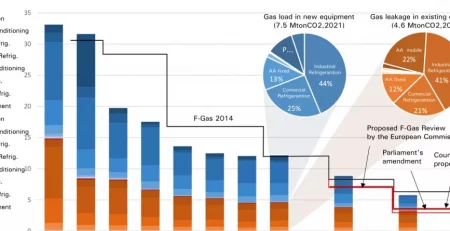F-gas or the prohibition of fluorinated gases
INTARCON2023-01-11T17:06:18+01:00Six years ago, the European Parliament approved Regulation (EU) No. 517/2014, known as the F-gas Regulation on the prohibition of fluorinated gases, which established a schedule for the reduction and gradual prohibition of current fluorinated greenhouse gases.
F-gas prohibitions in the coming years
In terms of the coming years, the prohibitions set out by this regulation that affect refrigeration units are as follows:
Prohibition date: 1 January 2020
Article 13 “Control of use”
- “From 1 January 2020, the use of fluorinated greenhouse gases, with a global warming potential of 2,500 or more, to service or maintain refrigeration equipment with a charge size of 40 tonnes of CO2 equivalent [CO2] or more, shall be prohibited”.
Exceptions: military equipment and equipment designed to cool products to temperatures below -50°C.
ANNEX III “Placing on the market prohibitions”
- “Refrigerators and freezers for commercial use (hermetically sealed equipment) that contain HFCs with GWP of 2,500 or more”.
- “Stationary refrigeration equipment, that contains, or the functioning of which relies upon HFCs with GWP of 2,500 or more except equipment intended for application designed to cool down products to temperatures above -50°C”.
Exceptions: military equipment.
Prohibition date: 1 January 2022
ANNEX III “Placing on the market prohibitions”
- “Refrigerators and freezers for commercial use (hermetically sealed equipment) that contain HFCs with GWP of 150 or more”.
- “Multipack centralised refrigeration systems for commercial use with a rated capacity of 40 KW or more that contain, or the functioning of which relies upon, fluorinated greenhouse gases with GWP of 150 or more. Except in the primary refrigerant circuit of cascade systems where fluorinated greenhouse gases with a GWP of less than 1500 may be used”.
Exceptions: military equipment.
As a result of the above, in practice, from 1 January 2020, the traditional R404A has ceased to be used in new units and installations in the European Union, and as of that date, installations have not been able to be charged with more than 10.2 kg of R404A.
In recent years, a range of mixtures of alternative HFCs to R404A have emerged, such as R407A, R407F, R442A, etc., all with corresponding commercial names. Moreovere, the only advantage of these refrigerant cocktails is that their GHG impact is somewhat lower, with a GWP factor of around 2,000, compared to that of R404A, which is 3922. However, all of them have a dangerous high discharge temperature, which compromises their use in negative cold applications without the proper precautions.
Therefore, for positive cold, everything points to the sector returning to R134a as a better option than the aforementioned cocktails for replacing R404A.
As of 2022, the new F-gas Regulation prohibit the use of HFCs in refrigerated cabinets and centralised installations of more than 40 kW.
An exception to the above in the F-gas Regulation opens the door to CO2, for negative cold production applications in cascade with an R134a cycle for positive temperature. Only in those cases does the F-gas Regulation allow the continued use of R134a in centralised installations with no power limit.
Evolution
There is currently no expiry date for the use of R134a, or refrigerant mixtures (R407A, R407F, etc.) in refrigeration units or small centralised installations of less than 40 kW. Even in condensing units of any power that operate with a single evaporator. Luckily for R134a, there appear to be more possibilities of having a definitive “eco-friendly” alternative. Refrigerants based on hydrofluoroolefins or HFOs appear to be good candidates.
The current regulatory framework has encouraged refrigeration unit manufacturers to opt for solutions with natural refrigerant gases with a low GWP, such as R744 (carbon dioxide), R717 (ammonia) or R290 (propane); overcoming any issues posed by their high working pressures, toxicity and or flammability.
In conclusion, the use of natural refrigerant gases combined with the selection of indirect refrigeration systems represents a huge commitment to a completely green future without an expiry date. Therefore resulting in systems with a very low charge that is very localised, minimising the risk of leaks, and an extremely low GWP (or even zero in the case of R717).
European Parliament resolution on the “F-gas” standard





